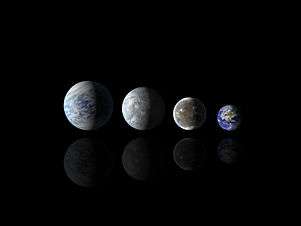2012 YQ1
|
| |
| Discovery[1] | |
|---|---|
| Discovered by | Andrey Oreshko and Timur Kryachko |
| Discovery site | "Elena" Telescope (Chilean Atacama desert) |
| Discovery date | 2012 Dec 19 |
| Designations | |
|
Apollo NEO, PHA | |
| Orbital characteristics[2] | |
| Epoch 13 January 2016 (JD 2457400.5) | |
| Uncertainty parameter 6 | |
| Aphelion | 3.11880 AU (466.566 Gm)[2] |
| Perihelion | 0.86916 AU (130.024 Gm)[2] |
| 1.99398 AU (298.295 Gm)[2] | |
| Eccentricity | 0.56411[2] |
| 2.82 yr (1028.4 d)[2] | |
| 12.74578°[2] | |
| 0° 21m 0.158s /day | |
| Inclination | 5.15193°[2] |
| 120.16813°[2] | |
| 42.09537°[2] | |
| Earth MOID | 0.00774939 AU (1,159,292 km) |
| Jupiter MOID | 1.87834 AU (280.996 Gm) |
| Physical characteristics | |
| Dimensions | ~220 m (720 ft)[3] |
| 21.1;[2] 20.9[4] | |
|
| |
2012 YQ1 is an Apollo near-Earth asteroid discovered on 19 December 2012 by astronomers Andrey Oreshko and Timur Kryachko using an "Elena" Telescope located in the Chilean Atacama desert.[1] With a 4-day observation arc, the asteroid had a 1 in 3 million chance of impacting in 2106.[3] With a 10-day observation arc, the asteroid had a 1 in 10 million chance of impacting in 2106.[4] On 5 January 2013, the asteroid passed 0.10 AU (15,000,000 km; 9,300,000 mi) from Earth.[2] It was removed from the Sentry Risk Table on 8 January 2013.[5] It has an observation arc of 32 days and an orbital uncertainty of 7.[2] Since the asteroid has a poorly known orbit, the cone of uncertainty quickly multiplies as a result of perturbations by the inner planets and prevents precise/reliable ephemeris data. Eliminating an entry on the Sentry Risk Table is a negative prediction; a prediction of where it will NOT be.

In the popular press
In 2013, an article, originally posted on The Voice of Russia[6] had a poorly researched headline stating "We have 93 years left till the next End of the World". This story was reposted on Space Daily, but then astronomer Phil Plait clarified that it was "a fascinating mix of fact and error. A lot of what it says is accurate, but the most important claim—that an asteroid will impact Earth in 2106—is simply wrong."[7]
See also
References
- 1 2 "MPEC 2012-Y15 : 2012 YQ1". IAU Minor Planet Center. 2012-12-21. Retrieved 2013-02-05. (K12Y01Q)
- 1 2 3 4 5 6 7 8 9 10 11 12 13 "JPL Close-Approach Data: (2012 YQ1)" (last observation: 2013-01-20; arc: 32 days). Retrieved 3 April 2016.
- 1 2 "Observations of small Solar-System bodies". HohmannTransfer. 2012-12-24. Retrieved 2013-02-06. (3.3e-07 = 1 in 3,030,000 chance)
- 1 2 "Observations of small Solar-System bodies". HohmannTransfer. 2012-12-30. Retrieved 2013-02-05.
- ↑ "Date/Time Removed". NASA/JPL Near-Earth Object Program Office. Retrieved 2012-03-19.
- ↑ Yulia Zamanskaya (5 February 2013). "We have 93 years left till the next End of the World: killer asteroid to hit Earth in 2106". The Voice of Russia.
- ↑ Phil Plait (13 Feb 2013). "No, An Asteroid Is NOT Going to Hit Earth in 2106". Slate.
External links
- 2012 YQ1 at the JPL Small-Body Database




